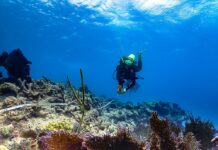The interior of the 12-year-old Honda CR-V is well insulated, soundwise, but still, the raindrops thumping on the roof were loud. Ellen Westbrook and I had been birding around Grassy Key between the bands of a seemingly endless storm. We were up there looking for a rare bird that we weren’t going to find, but we didn’t know that yet.
There are quite a few houses on Grassy Key, but also quite a few salt ponds that are often full of birds. We’d seen several when we were walking around. But then the rain came.
My camera is advertised as being weather-sealed, which differs, I believe, from waterproof, though I’m not sure how. At a certain point in a Florida deluge, there doesn’t seem to be an appreciable difference between standing in the open air and sitting in a pool, and testing the limits of the definition of weather-sealed didn’t seem a wise decision financially.
This was probably our fourth retreat to the car. We didn’t know how long the rain band would last, but we weren’t yet ready to give up on the rare bird. We’d pulled off the side of the road and down a little dropoff, though not all the way, lest we get stuck. Then we sat, staring straight ahead.
A car windshield, like a camera, can frame the world for you. The stage set in front of us featured mangroves, salt ponds, beige Keys mud and dark clouds. And within that tableau were a few potential protagonists, divided into two camps – a troupe of least terns and a troupe of reddish egrets.
The least terns varied in number. Sometimes there was only one, sometimes eight or nine.
Least terns are so light and quick that when they fly up it looks as if they’re pulled by a force outside the realm of aeronautics, almost as if they’ve been raptured. They land almost as quickly, as if they’d been raptured accidentally and the unnamed forces of the universe were trying to put them back as fast as possible so no one would notice.
Least terns in the Keys are most commonly seen in the air over parking lots near flat-roofed structures — grocery stores, office buildings and government buildings. In the proper order of things, least terns would be nesting on beaches, but there aren’t a lot of beaches in the Keys, or Florida in general, that aren’t dominated by human activity, which makes breeding on them a losing proposition. So they generally nest on gravel rooftops.
Ellen knows a thing or two about least terns. For close to a decade she has worked as a volunteer surveyor, going around Key West once a week during breeding season, monitoring the least tern population.
Sitting there, she pointed out that there weren’t any gravel rooftops for miles, so these birds were probably nesting somewhere on some nearby, slightly elevated upland surrounded by the salt ponds. I was so used to associating them with modern buildings I’d kind of forgotten it was possible for them to nest in more natural habitats.
After a while we noticed one tern that hadn’t joined all the hyper active peripateticism. She, or he – least terns are sexually monomorphic – was just sitting in the same spot for minutes on end.
Ellen and I both lifted our binoculars to see if maybe a least tern was sitting on an egg right in front of us. While a car windshield may be a good framing device, it also warps the light somewhat, like a lens. It’s not something you notice so much naked-eyed or wearing glasses while driving, but it’s definitely something you notice looking through binoculars, because it can be difficult, if not impossible, to focus. And I had the wipers on slow, so the view would slowly blur even further, then periodically get squeegeed clean for a few moments, before blurring again.
All of which can make it difficult to ascertain whether a 9-inch, 1.5-ounce bird 50 yards away is sitting on an inch-long egg. Eventually, though, it was clear there was daylight under the bird, meaning he or she was standing, and not on an egg.
Maybe the disinclined-to-move least tern had enjoyed a successful morning plunge diving for fish and was just digesting. Maybe he or she just wasn’t buying into all the excitability.
Meanwhile, the troupe of reddish egrets just stood there, which was also a little odd.
I tend to think of reddish egrets as solo acts, probably because in the heron and egret world, they are what the kids used to call a little extra. It’s their feeding technique, which relies largely on drama, fakery and chaos. Whereas wading birds like great egrets, great blue herons or tricolored herons often stand stock still in, or immediately next to, water, waiting for the perfect moment to strike and catch a fish, reddish egrets run around like freaks, splashing, throwing their wings out, spinning, changing direction, stopping quickly. All with the intention of confusing and scaring small fish into showing themselves and inadvertently offering themselves up as meals. That all requires a lot of space. Which is why, to my mind, you tend to only see a single reddish egret working a salt pond or a tidal flat. Even an agent of chaos can only handle so much chaos.
So why were there four reddish egrets standing in the same patch of pond? Reddish egrets come in two color morphs – the purplish/mauve color that gives them their name and white. These were all dark birds, two of them the reddish of adults, and two of them with the paler, chalkier plumage (as David Sibley describes it) of juveniles. It was a family unit, if an unusually subdued one.
Since reddish egrets are visual hunters, there wasn’t much point in them executing their usual antics in heavy rain. So for a long time they just stood.
The kids must have grown hungry, though, because when the rain subsided slightly, they began to move around, slowly and seemingly without a lot of intent at first, but then warming up into their sudden sprints across the pond.
As the rain lessened, the parents followed suit, everyone eventually moving out of the frame.























